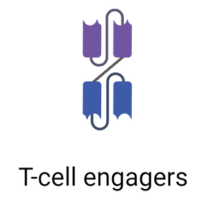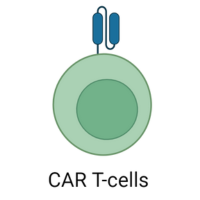Mathematical models can assist in broadening use of IO drugs to treat autoimmunity
By: Saheli Sarkar, PhD,
Marc Presler, PhD
March 26, 2024
Connecting Cancer and Autoimmunity
The dosing regimens in oncology may not directly inform the optimal choices in autoimmune diseases from an efficacy or safety perspective.
The level of immune activation is enormously influential for the progression of both cancer and autoimmune diseases (Elkoshi, 2022). While acting in opposite extremes, the common biological pathways have hinted that drugs developed for one indication could be useful for the other.
Indeed, the leap from immuno-oncology to autoimmune disease has enjoyed early success. Therapeutics originally developed to treat B cell cancers, including CD19 or BCMA-targeting CAR-T cells, as well as the anti-CD20 antibody Rituximab, have recently shown promising results for autoimmune disorders that have had limited treatment options (Müller et al., 2024, Mackensen et al., 2022, Granit et al., 2023, Sans-Pola et al., 2023). Specifically, the disorders systemic lupus erythematosus and myasthenia gravis are each characterized by the presence of auto-antibodies produced by plasma cells, which are members of the same lineage that over-replicate in several blood cancers. Reducing that cell population appears to benefit patients in both disease classes.
Given the effort and expense necessary to develop immuno-oncology (IO) assets, the motivation is high to expand their application to treat unmet needs in autoimmunity from a business and clinical perspective. While such repurposing is appealing, immune modulating drugs are complex. The dosing regimens in oncology may not directly inform the optimal choices in autoimmune diseases from an efficacy or safety perspective.
However, approaches such as quantitative systems pharmacology (QSP) models have increasingly supported the discovery and development of IO drugs. By capturing key elements of drug pharmacology and cell biology, these models can assist in accelerating the reuse of IO drugs in the autoimmune space. Here, we focus our attention on T-cell engagers and CAR-T therapies as illustrative examples for these repurposing efforts.
T-cell Engagers (TCEs)
Accounting for target density and cell numbers accurately will be critical in assessing the new doses for repurposed TCEs.
Bispecific antibodies and T cell engagers (TCE) are exciting new cancer treatments because of their potency, target specificity, and improved developability vs cellular therapies. For these same reasons, they could be the next frontier in autoimmune therapies. A mechanistic QSP model can predict the efficacious doses of repurposed bispecifics by integrating the known binding properties, mechanism of action, pharmacokinetics (PK) and pharmacodynamic (PD) responses with quantitative details of the drug targets and desired metrics of efficacy. 
For bispecific TCEs, their activity depends on optimizing simultaneous binding to the T cell and tumor-associated targets. Applied BioMath has previously developed IO-focused QSP models to support preclinical translation of CD19 TCEs (Flowers et al., 2023) and predict starting doses for a CD3 bispecific construct using a MABEL approach by translating tumor-killing data from mouse xenograft models. This model accounts for several aspects impacting dose selection, including the affinity and avidity of the binding arms, the effector to target cell ratio in the site of action and drug sinks created by soluble targets (reviewed by Betts et al., 2020).
Importantly, this particular model can appropriately capture the distinct dosing impact of increased expression of a target per cell vs changes in the overall number of cells. Given the difference in expression of targets in cancer vs autoimmune disease areas, accounting for target density and cell numbers accurately will be critical in assessing the new doses for repurposed TCEs.
In addition, repurposed IO QSP models can assist autoimmune programs at early stages with various critical decisions, such as target selection and feasibility of targeting one versus multiple molecules, or lead selection by determining optimal affinity ranges and other sensitive drug parameters for a desired bispecific drug format.
(Image created with BioRender.com)
CAR-T Cells
 Dose prediction for CAR-T cells is more complicated since efficacy depends on the expansion of CAR-T cells, which in turn depends on a complex interplay of antigen availability, target binding affinity, disease burden and dose administered (Rotte et al. 2022). The receptor binding models described above can be expanded to include cell kinetics and dose-dependent efficacy to make them applicable to ‘living’ drugs such as CAR-T cells (Singh et al., 2021).
Dose prediction for CAR-T cells is more complicated since efficacy depends on the expansion of CAR-T cells, which in turn depends on a complex interplay of antigen availability, target binding affinity, disease burden and dose administered (Rotte et al. 2022). The receptor binding models described above can be expanded to include cell kinetics and dose-dependent efficacy to make them applicable to ‘living’ drugs such as CAR-T cells (Singh et al., 2021).
While clinical PK/PD data from prior indications may be available, dosing confidence for CAR-T cells can be improved by using models to incorporate additional preclinical PK/PD data from relevant disease models to make robust dose predictions.
(Image created with Biorender.com)
Evaluating Toxicity Risks
Starting doses and efficacious doses may have to be adjusted significantly in clinical trials to avoid life-threatening risks during repurposing.
There are significant safety risks involved with any immunotherapy that must be carefully evaluated to achieve the optimal therapeutic index. In non-cancer therapies like autoimmunity, the bar is even higher for mitigating toxic side effects.
Both CAR-T cells and TCEs can induce Cytokine Release Syndrome (CRS) in cancer patients, although the severity of symptoms vary widely. Given the already hyperactivated state of the immune system in autoimmune disorders, any further perturbation, such as increased cytokines associated with TCEs and CAR-T cells, could be cause for alarm. This means that both starting doses and efficacious doses may have to be adjusted significantly in clinical trials to avoid life-threatening risks during repurposing.
Instead of an empirical approach of using safe doses from other indications, mechanistic modeling of drug-induced toxicology can provide more insight into potential risk factors and assist dose selection, frequency and route of administration. With the extreme clinical heterogeneity in any given autoimmune disorders as well as the variability in immunotherapy-induced toxicity incidences, there may be a subset of patients that benefit from these drugs while others are at particularly high risk; simulation of virtual patients by QSP modeling can help with streamlining of clinical trials (Chelliah et al., 2021). In addition, feasibility of mitigation strategies (such as priming doses, cytokine blockade etc) and their timings can also be tested in silico to alleviate some of these concerns.
In the end, the choice of a repurposed drug may come down to a balance of safety and efficacy. In IO applications, TCEs generally trigger CRS less than CAR-T cells, but are slightly less efficacious than CAR-T cells. Quantitative models may help companies evaluate these same risks and tradeoffs in the autoimmune space.
Empowering Drug Repurposing with Quantitative Approaches
Quantitative approaches can leverage the investment made in the IO space to bring a new generation of therapies to those suffering from autoimmune diseases with the appropriate urgency.
Repurposing of drugs for new indications is a long-standing practice in the pharmaceutical industry. While some notable examples of repurposing happened by chance in the past, the likelihood of successful applications have increased with the combination of advanced omics technologies that delve into disease signatures and computational methods (data mining, machine learning, artificial intelligence) that integrate drug-target-host interactions (Pawar et al., 2023). The same will be true for mechanistically informed QSP models that have shown to be effective in guiding dose projection, drug and study design.
Through collaboration and thoughtful partnership, these quantitative approaches can leverage the investment made in the IO space to bring a new generation of therapies to those suffering from autoimmune diseases with the appropriate urgency.
Special thanks to Selena Lorrey for comments on this piece.
Request a consultation for your autoimmune project
References
Betts et al. Mechanistic Quantitative Pharmacology Strategies for the Early Clinical Development of Bispecific Antibodies in Oncology. Clin Pharmacol Ther. 2020 Sep; 108(3): 528–541. PMID: 32579234
Chelliah et al. Quantitative Systems Pharmacology Approaches for Immuno‐Oncology: Adding Virtual Patients to the Development Paradigm. Clin Pharmacol Ther. 2021 Mar; 109(3): 605–618. PMID: 32686076
Elkoshi. Cancer and Autoimmune Diseases: A Tale of Two Immunological Opposites? Front Immunol. 2022 Jan 25:13:821598. PMID: 35145524
Flowers et al. A next generation mathematical model for the in vitro to clinical translation of T-cell engagers. J Pharmacokinet Pharmacodyn. 2023 Jun;50(3):215-227. PMID: 36790614
Granit et al. Safety and clinical activity of autologous RNA chimeric antigen receptor T-cell therapy in myasthenia gravis (MG-001): a prospective, multicentre, open-label, non-randomised phase 1b/2a study. Lancet Neurol. 2023 Jul;22(7):578-590. PMID: 37353278
Mackensen et al. Anti-CD19 CAR T cell therapy for refractory systemic lupus erythematosus. Nat Med. 2022 Oct;28(10):2124-2132. PMID: 36109639
Pawar et al. Unlocking therapeutic potential: integration of drug repurposing and immunotherapy for various disease targeting. Am J Transl Res. 2023; 15(8): 4984–5006. PMID: 37692967
Rotte et al. Dose–response correlation for CAR-T cells: a systematic review of clinical studies. J Immunother Cancer. 2022; 10(12): e005678. PMID: 36549782
Sans-Pola et al. Off-label use of rituximab in patients with systemic lupus erythematosus with extrarenal disease activity: a retrospective study and literature review. Front Med (Lausanne). 2023; 10: 1159794. PMID: 35145524
Singh et al. Bench-to-bedside translation of chimeric antigen receptor (CAR) T cells using a multiscale systems pharmacokinetic-pharmacodynamic model: A case study with anti-BCMA CAR-T CPT Pharmacometrics Syst Pharmacol. 2021 Apr;10(4):362-376. PMID: 33565700

